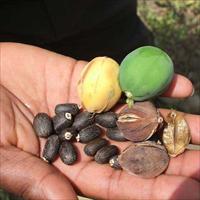KENYA: Boosting biofuels without compromising food security

The oil-rich seed of a poisonous shrub that thrives in arid climates with poor soil lies at the heart of plans by Kenya to reduce its dependence on imported fossil fuels without threatening food security.
“We are definitely focusing on the jatropha plant for oil production,” Faith Odongo of the Ministry of Energy told IRIN.
In May 2008, the ministry unveiled a five-year strategy to develop the bio-diesel industry to “enable more Kenyans to enjoy and derive comfort from the supply of bio-diesel for agricultural production, employment creation, rural-urban balance and blending in the motor vehicle industry”.
The strategy includes detailed proposals for the cultivation of the jatropha curcas shrub as well as the processing of its seeds, also known as Barbados nuts or Physic nuts, and the distribution of the resulting bio-diesel for transport and power generation.
Odongo said the key objectives of the government strategy included the diversification of rural energy sources by promoting the replacement of kerosene -commonly used for domestic use - by bio-diesel.
She said the outlook was “positive” and that pilot cultivation projects in various parts of the country had been encouraging. “Research trials in Mpeketoni, Lamu [a coastal town] where there is no power [have shown] people using the little oil they got from the seeds to light their lamps.”
Odongo said the oil extracted from the seeds could be used in community managed bio-diesel electricity generators.
The government predicts that as a result of biofuel development, by 2012, Kenya’s imports of diesel will have fallen by five percent and the proportion of Kenyans who use kerosene for lighting will have dropped from three-quarters to half of the total population.
Cultivation of jatropha in arid areas brings another benefit, according to the strategy paper – the improvement of the existing forest cover would help counter “the effect of deforestation and degradation as well as serving as carbon sink”.
The strategy adds: “The use of marginal land ensures that the high potential areas are not converted to energy production areas and therefore it guards against competition between biofuels and food production.”
Setting up the Kenya Biodiesel Association, which brings together all the stakeholders in the sector, is also part of the strategy, as a “one-stop shop” to coordinate the industry’s various sectors.
In recent years, various organisations and individual farmers have been experimenting with jatropha production.
Elijah Ndogo, a coffee farm manager in Ruiru, central Kenya, has planted six hectares with jatropha.
“We use a lot of diesel in the factory, sometimes we pollute the environment, we were looking for an alternative to cut costs,” he told IRIN.
It has been an educational experience for Ndogo, who initially expected near-miraculous results from his new crop, but now realises he has to wait another three years before his plant reaches maturity and will produce enough seeds for oil extraction. “We thought it would reach full maturity after two years,” he said.
“It is too cold here, the rate of growth is lower, the results will be belated,” he said, adding that he had also lost some of the seedlings to cutworms and millipedes in 2007.
The prices of seeds have also gone up, he said: “In 2006, a kilo seeds went for 1000 shillings (US$15), today half a kilo of seeds goes for 3000 shillings ($46), it’s very expensive.”
According to Miyuki Liyama, an economist with the International Center for Research in Agroforestry (ICRAF), when farmers began planting jatropha in 2006, “they did not have enough scientific knowledge and they did not know the agronomy of jatropha”.
She also said the government would have to do more to make its strategy viable. “There is no ready market for biofuel in Kenya yet,” she said.
According to media reports, this hasn’t stopped a Japan-based company, Biwako Bio-Laboratory Inc, from announcing a 10-year, US$19.4 million commercial bio-diesel project using jatropha seeds grown over an eventual 100,000 ha of land.
 Back and Next - Back and Next
Back and Next - Back and Next See Also - See Also
See Also - See Also